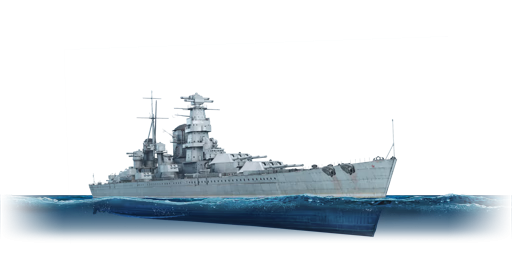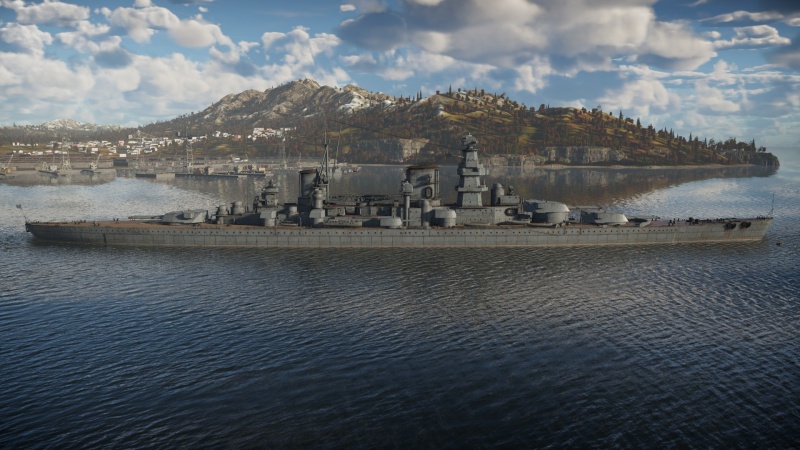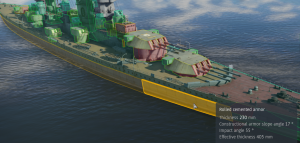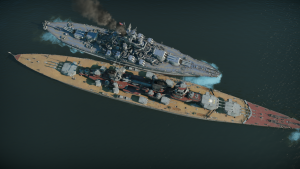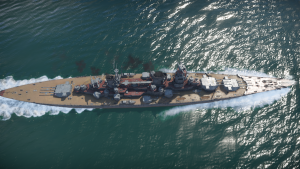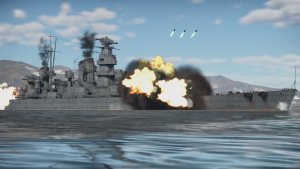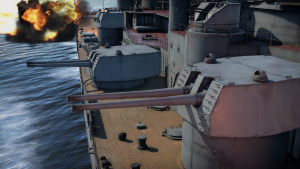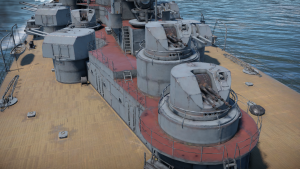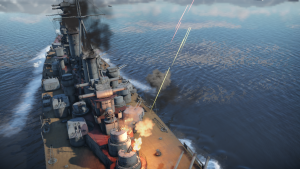Kronshtadt
Contents
Description
The Project 69, Kronshtadt, project was an incomplete Soviet battlecruiser (officially designated a "heavy cruiser") built under the Soviet Navy's Project 69. The first iterations of the Project 69 design were drafted in the mid-1930s in the form of a heavy cruiser intended to defeat treaty cruisers of other naval powers. Over several years, the project evolved and grew in size and displacement, ultimately resulting in a 41,540-ton battlecruiser configuration. Kronshtadt's construction began in 1939, but soon after the German invasion of the Soviet Union permanently halted construction of the Project 69 ships. After the conclusion of the Second World War, the Project 69 design was ultimately considered obsolete as well as economically infeasible, and the Kronshtadt was subsequently scrapped.
The Kronshtadt was introduced in Update "Danger Zone" and is a unique battlecruiser in the Soviet tech tree. She stands out from other Russian and Soviet capital ships with her high speed and fast reload, making her very well-suited to hunting down cruisers. In addition, the main 305 mm guns of the Kronshtadt also have exceptionally good muzzle velocities, and therefore the AP shells have good penetration at close range. The Kronshtadt also has a significantly better AA suite compared to the Sevastopol and Imperatritsa Mariya class dreadnoughts, though her protection isn't increased compared to the aforementioned dreadnoughts; while the armour is largely resistant to cruiser-calibre gunfire, it does not fare as well against other capital ships. That being said, the hull of the Kronshtadt is spacious and provides decent survivability despite the relatively middling armour plating of the ship.
General info
Survivability and armour
The deck of the citadel has three layers of armour, the first is only 14 mm, intended to fuse shells and bombs prematurely. Under this is the main armour deck, 90 mm of RHA (rolled homogeneous armour). The final layer is a 30 mm splinter deck, which tapers to 15 mm over the torpedo bulges. The deck of the fore and aft of the ship have only a single 10 mm layer.
The main turrets have sloped turret faces with 305 mm of RCA, the turret sides and roof are a uniform 125 mm RCA, the rear has the same 305 mm as the turret face, meanwhile the more vulnerable gunshields only have 152 mm of RHA. The barbettes are angular with 9 sides and have 330 mm of RCA, however once under the main armour deck the barbettes thin all the way down to 30 mm of RHA. Lastly, the turret rangefinders are covered in 30 mm splinter protection.
The bridge of the vessel is fully protected by RCA, with 330 mm and 275 mm armour plates on the front and back respectively, with 260 mm on the sides and a 125 mm roof, while the radio room below the bridge is completely enclosed in 50 mm RHA. The fire control room at the top of the superstructure also has 50 mm all around.
The secondary 152 mm turrets have 100 mm faces, 50 mm sides and roofs, and 110 mm rears, with 75 mm barbettes. The 100 mm turrets are 50 mm all around with 40 mm barbettes. The 37 mm turrets have 14 mm all around with 20 mm barbettes.
The funnels and fire directors are protected by 20 mm and 14 mm splinter protection respectively. All of the auxiliary turret and superstructure protection is made of rolled homogeneous armour (RHA).
In terms of underwater protection, the ship uses American-style torpedo bulges with 4 longitudinal bulkheads, rated to be able to absorb 250 kg of explosive weight, though the original design specifies that it should be able to withstand 500 kg. The bulges cover 61% of the ships length and have a maximum depth of 6 m, tapering to 4 m fore and aft.
Something that may be important in terms of survivability is the sheer size of the vessel. At 41kt, the Kronshtadt is the second heaviest playable vehicle in the entire game, second only to HMS Hood. Combined with being a battlecruiser built for high speeds, it has a very long hull that makes for a huge target. The ship can be more easily targeted and may end up being hit by more shells in any given salvo than a smaller vessel would have been hit by. That being said, the size does help when combatting aircraft as the more spread out internals and modules can result in bomb hits destroying comparatively less of the vital parts of the ship than if they had all been clustered up within a smaller hull.
As a side note, the main armour belt curves with the hull of the ship, resulting in the foremost and rearmost (but mostly the foremost, and conveniently right in front of the turrets) armour plates having a noticeable degree of incline outwards rather than standing vertically, which can substantially increase the effective thickness against shells hitting those particular areas, especially if the ship is already angled.
Lastly, the ship has a hefty crew complement of 1,406. Though not the most by capital ship standards, this is still a more than respectable number.
Overall, the Kronshtadt is a surprisingly damage resistant ship for a battlecruiser. Though only 230 mm, the main belt can still block high calibre AP shells when angled and the belt being relatively tall and lengthy makes it excellent for blocking HE fragments and catching shells that would have otherwise plunged into the upper decks. The layered armoured deck is great at resisting some of the smaller bombs and can shrug off any armour piercing shells in game except possibly at extremely long range. The turrets are reasonably sturdy, though can occasionally be knocked out by armour piercing shells hitting the relatively thin sides, however the ships ammunition doesn't tend to explode very often and if it does, the vessel can even survive one or two of the main magazines detonating, provided the payer keeps on top of damage control. The ship in general is very HE-resistant, due to a number of factors, but mainly thanks to how the ship has a relatively small number of AA guns, which are all safe within fully enclosed turrets and covered in anti-fragmentation armour rather than being in open mounts spread across the deck. In most circumstances, the ship can practically ignore cruiser fire (at least, from a single ship) at anything other than short ranges and thanks to the torpedo protection, the ship is nearly immune to torpedoes which aren't strong enough to overpower your defences.
The ship is still vulnerable to other capital ships when not angled. If you're in a duel with another battleship or battlecruiser, point the bow as much as you can toward them while being able to fire all main turrets, though if you've taken major damage you may opt to angle even further at the expense of not being able to fire your aft turret. Take care when fighting heavy cruisers at close range, such as the Prinz Eugen, Admiral Hipper, or Des Moines, as they can punch through your belt armour at close range with ease, creating significant risk of ammunition detonation.
Mobility
The Kronshtadt uses 3 propeller shafts, powered by Brown Boveri steam turbines and 12 x 7u-bis water-tube boilers contained in 3 engine blocks, which are ducted into two funnels, propelling the ship to an impressive maximum speed of 61 km/h (71 km/h in arcade), faster than HMS Hood or IJN Haruna (57 km/h) and slightly faster than the battleship Scharnhorst (59 km/h).
Though the vessel is extremely large, the acceleration and deceleration of the vessel is decently quick enough that you can still utilise it to dodge fire from other capital ships.
Being a long and heavy ship, the 41,000 t Kronshtadt has a large turning circle and manoeuvres like a brick when stock, though the ship becomes noticeably more responsive and agile with all the mobility upgrades. The ship also tends to keel to the side somewhat when making high speed turns, especially when fully upgraded, which can thoroughly interrupt your aiming and make it physically impossible to aim at closer range targets on the side you're turning towards until you've stopped turning and recovered from the list.
| Mobility Characteristics | |||
|---|---|---|---|
| Game Mode | Upgrade Status | Maximum Speed (km/h) | |
| Forward | Reverse | ||
| AB | |||
| Upgraded | 71 | 34 | |
| RB/SB | |||
| Upgraded | 61 | 29 | |
Modifications and economy
Armament
Primary armament
The Kronshtadt is armed with a total of 9 x electrically-powered 305 mm 54-calibre B-50 cannons, arranged in 3 x large triple turrets, two superfiring fore and one aft. The ship carries 100 shells per gun, 900 in total. 100 main battery shells per gun mean only 100 full broadsides, little more than half an hour's worth of continuous firing. You may run out of main battery shells after extended engagements, such as in EC.
The cannons can be depressed to -3° and elevated to +45° with an elevation rate of 10°/s, while the turrets can traverse at an impressive 5°/s, giving you relatively good gun handling for turrets of this size. The cannons have an average level of dispersion, not too accurate, not too spaced out.
The turrets have a stock reload of 26 seconds, but can drop to 20 seconds with a max crew, which is considerably faster firing than most other ships armed with this calibre, though not quite as fast firing as the Scharnhorst with its 283 mm guns.
Unlike other Soviet capital ships, the Kronshtadt does not have any SAP ammunition for the main turrets, having only access to HE and AP shells.
The high-explosive shell weighs 314 kg and has a high filler mass, 55.41 kg of TNT with 72 mm of explosive penetration at any angle. The muzzle velocity of the shell is 1,000 m/s, the highest of any battleship calibre shell in game, making long range aiming much easier at the expense of not being able to arc shots over the tops of islands quite as well. The HE shell is great for destroying any targets, from patrol boats up to some of the more heavily armoured cruisers and some capital ships. When fighting capital ships, the shell is very handy for knocking out unprotected crew, setting devastating fires and creating holes for flooding, which can occasionally sink enemy vessels if they don't keep on top of repairing leaks. Plus, if you strike your enemies turrets with this shell then there's a high chance you will destroy their gun barrels and cripple their firepower until they're repaired.
The armour-piercing shell weighs 470.9 kg and has a bursting charge of 12.2 kg of A-IX-2, equivalent to 18.79 kg of TNT, which is a brilliant level of filler for an AP shell. For comparison, the USS Arizona (356 mm guns) has 14 kg in its AP shells and the Scharnhorst (283 mm guns) has only 7 kg. The armour penetration statistics are just as impressive, with the shell cleaving through 677 mm of armour at 1 km away and still being capable of punching past 333 mm at 15 km away. This is a comparable level of penetration to 380 mm cannons. With a fuse delay of 0.05 seconds, the shell can often pass right through soft targets like boats and destroyers, dealing little damage other than flooding, though is still useful against cruisers that have a lot of armour or that are angled toward you. The shell also has a muzzle velocity of 900 m/s which, while lower than the HE shell due to being much heavier, is still fairly fast and still allows for relatively easy aiming at long range.
Both of these shells are of exceptional quality and together give you the capability to defeat any vessel in the game.
| Penetration statistics | |||||||
|---|---|---|---|---|---|---|---|
| Ammunition | Type of warhead |
Penetration @ 0° Angle of Attack (mm) | |||||
| 1,000 m | 2,500 m | 5,000 m | 7,500 m | 10,000 m | 15,000 m | ||
| 12 inch HE patt. 1928 | HE | 72 | 72 | 72 | 72 | 72 | 72 |
| 12 inch APCBC | APCBC | 677 | 622 | 541 | 472 | 415 | 330 |
| Shell details | ||||||||||||
|---|---|---|---|---|---|---|---|---|---|---|---|---|
| Ammunition | Type of warhead |
Velocity (m/s) |
Projectile mass (kg) |
Fuse delay (s) |
Fuse sensitivity (mm) |
Explosive mass (TNT equivalent) (kg) |
Ricochet | |||||
| 0% | 50% | 100% | ||||||||||
| 12 inch HE patt. 1928 | HE | 1,000 | 314 | 0 | 0.1 | 55.41 | 79° | 80° | 81° | |||
| 12 inch APCBC | APCBC | 900 | 470.9 | 0.05 | 17 | 18.79 | 48° | 63° | 71° | |||
Secondary armament
The secondary armament of the Kronshtadt consists of 8 x 152 mm 57-calibre B-38 cannons, arranged in 4 x twin turrets near the front of the superstructure, two on the starboard side, two on the port side, with the foremost turrets inboard and on raised barbettes, giving them good arcs of fire. They carry 150 shells per gun, 300 per turret, 1,200 in total.
These turrets carry the same cannons that can be found in the main armament of the Chapayev- and Sverdlov-class light cruisers, renowned for their excellent guns. You have decent gun handling with these turrets, with elevation limits at -5° to +45°, an elevation rate of 13°/s and a traversal rate of 7.2°/s. Your turrets have a 10-second reload, 8 with a max crew.
You have four shell types to choose from :
- HE - 55 kg mass, 950 m/s muzzle velocity, 6 kg of TNT filler with 0.1 mm fuse sensitivity and 50 mm of explosive penetration at any angle.
- SAPBC - 55 kg mass, 950 m/s muzzle velocity, a filler of 5.9 kg of TNTeq with a fuse sensitivity of 7 mm and 0.03 seconds. Penetration is 172 mm at 1 km, 74 mm at 10 km and 52 mm at 15 km.
- APCBC - 55 kg mass, 950 m/s muzzle velocity, 1.69 kg of TNTeq for filler with a fuse sensitivity of 7 mm and 0.03 seconds. Penetration is 333 mm at 1 km, 143 mm at 10 km and 100 mm at 15 km.
- HE-TF - 54.23 kg mass, 950 m/s muzzle velocity, 10.1 kg of TNTeq with 0.01 mm fuse sensitivity and 62 mm of explosive penetration at any angle, equipped with a timed fuse for use against aircraft.
Now whilst these are good guns in cruiser terms, they're not all that much for a battlecruiser like the Kronshtadt. You only have a maximum broadside of 4 guns and the reload isn't exactly the fastest. They're not of much use against small boats because your anti-aircraft suite can take care of them much more effectively. While you can do some damage to cruisers and capital ships with the 152 mm cannons, they really don't add much to the damage output of the main 305 mm cannons. The main guns can fire almost as fast as some heavy cruisers and deal overwhelming damage in comparison to the 152 mm, meaning that using the secondary guns against major ships won't make a noticeable difference. It's therefore recommended to load the guns with the HE-TF shells so they can be of use against aircraft by acting as heavy AA batteries. With over 6 kg of filler, the shells can be very effective if they detonate in the vicinity of an inbound aircraft and have more range than anything in your dedicated AA suite. As before, the slow reload rate is not ideal in this role, but they have more use against aircraft than warships and might just save you when conventional AA fails. Plus, the high explosive filler means they can still be of occasional use against soft surface targets.
| Penetration statistics | |||||||
|---|---|---|---|---|---|---|---|
| Ammunition | Type of warhead |
Penetration @ 0° Angle of Attack (mm) | |||||
| 1,000 m | 2,500 m | 5,000 m | 7,500 m | 10,000 m | 15,000 m | ||
| OF-35 HE | HE | 50 | 50 | 50 | 50 | 50 | 50 |
| B-35 AP | APCBC | 333 | 287 | 226 | 178 | 143 | 100 |
| PB-35 SAP | SAPBC | 172 | 148 | 117 | 92 | 74 | 52 |
| ZS-35 AA | HE-TF | 62 | 62 | 62 | 62 | 62 | 62 |
| Shell details | ||||||||||||
|---|---|---|---|---|---|---|---|---|---|---|---|---|
| Ammunition | Type of warhead |
Velocity (m/s) |
Projectile mass (kg) |
Fuse delay (s) |
Fuse sensitivity (mm) |
Explosive mass (TNT equivalent) (kg) |
Ricochet | |||||
| 0% | 50% | 100% | ||||||||||
| OF-35 HE | HE | 950 | 55 | 0 | 0.1 | 6 | 79° | 80° | 81° | |||
| B-35 AP | APCBC | 950 | 55 | 0.03 | 7 | 1.69 | 48° | 63° | 71° | |||
| PB-35 SAP | SAPBC | 950 | 55 | 0.03 | 7 | 5.9 | 48° | 63° | 71° | |||
| ZS-35 AA | HE-TF | 950 | 54.23 | 0 | 0.1 | 10.1 | 79° | 80° | 81° | |||
Anti-aircraft armament
The main anti-air armament of the Kronshtadt is made up of 28 x 37 mm 67-calibre water-cooled 70-K autocannons. What's unique about the AA on the Kronshtadt is that all the anti-air guns are are grouped into a handful of miniature turrets, whereas pretty much every other vessel in game has at least some of its anti-air guns as open air gun mounts, which are highly vulnerable to explosive damage. The vessel has seven quad turrets in total with three positioned on the fore of the superstructure and four on the aft. This is complemented by 8 x 100 mm 56-calibre B-34 dual purpose cannons arranged in four twin turrets, all of which are grouped on the rear of the superstructure. The 37 mm guns each carry 2,000 rounds of ammunition each, 8,000 per turret, 56,000 in total, while the 100 mm turrets carry 300 rounds per gun, 600 per turret and 2,400 in total. The 37 mm turrets have elevation limits of -10° to +85°, enabling them to fire in nearly any direction, whilst they can traverse at 20°/s and elevate at 15°/s. The guns fire a 732 g shell at a muzzle velocity of 880 m/s. With a reload speed of 0.4 seconds, each gun has a rate of fire of 126 RPM, giving each turret a rate of fire of 504 RPM. With an average of 5 turrets on a broadside target, that lets you fire at an inbound target with a potential of at least 2,500 RPM.
The 100 mm turrets have almost identical elevation limits of -8° to +85°, though the targeting speed is lesser, at 12°/s traverse and 10°/s elevation. They fire a 15.6 kg HE-TF shell at a muzzle velocity of 900 m/s every 4 seconds for a rate of fire of 30 RPM per turret, 60 RPM on a broadside. Overall, and despite having relatively few anti-air turrets, the Kronshtadt has a decent level of AA capability that wouldn't be out of place on your average cruiser. Now, the 37 mm turrets fire all the guns on the turret simultaneously, so there's a noticeable gap between each shot as they reload, but you can occasionally get circumstances where, due to overheating and such, the turrets end up staggering the fire of their 4 guns, giving a much more useful density of fire. Unfortunately, there is no option or button to allow for staggered fire at all times. The turrets are not bad when it comes to accuracy as well, often striking aircraft at medium range and nailing aircraft that get too close, though as always, this can heavily depend on the aircraft in question and who is flying it. The 37 mm cannons don't usually need many hits to bring a plane down. Unfortunately though, due to all being in entire turrets, the guns aren't the fastest to respond to aircraft that appear from nowhere or that get close enough to outrun the rate the turrets can traverse. The 100 mm cannons can create a reasonably dense flak field that can reach out much further than the 37 mm guns, though the relatively low calibre of the cannons and only having timed fuses instead of proximity fuses means that it's not uncommon for aircraft to just fly through the flak while taking little to no damage unless a lucky shell detonates right next to the plane.Scout plane
Usage in battles
Describe the technique of using this ship, the characteristics of her use in a team and tips on strategy. Abstain from writing an entire guide – don't try to provide a single point of view, but give the reader food for thought. Talk about the most dangerous opponents for this vehicle and provide recommendations on fighting them. If necessary, note the specifics of playing with this vehicle in various modes (AB, RB, SB).
Pros and cons
Summarise and briefly evaluate the vehicle in terms of its characteristics and combat effectiveness. Mark its pros and cons in the bulleted list. Try not to use more than 6 points for each of the characteristics. Avoid using categorical definitions such as "bad", "good" and the like - use substitutions with softer forms such as "inadequate" and "effective".
Pros:
- Highly effective main calibre shells
- Fast reload for the main turrets
- Effective armour layout
- Large crew count
- Generally resistant to HE fragmentation and bombs
- Surprisingly capable AA
- High top speed, great for EC battles
Cons:
- Main belt can easily be penetrated when not angled
- Huge and easily recognisable target
- Wide turn radius, plus a tendency to lean too much to the side in a turn
- No proximity fuse AA shells, only time-fused shells
- Secondary battery with a low damage output
- Limited ammunition count for the main guns if you play Enduring Confrontation
History
Devblog
During the 1930s Soviet shipbuilders were intensely working on designing new warships for the Soviet Navy. Among the top priorities was the development of a new cruiser design that could counter 10,000-ton cruisers of other nations. Several design proposals were submitted by 1935, of which none passed initial approval. The navy requested a new design, but the signing of a naval agreement with Great Britain in 1937 caused the requirements to collide with another similar project, ultimately resulting in this effort to also be canceled shortly afterwards.
Nonetheless, the Navy still sought to construct a fast and strong counter to other nations' cruisers, resulting in the development of the Project 69 battlecruiser. However, the already modified requirements for a 26,200-ton vessel proved to be insufficient after the Soviet Navy found out about the specifications of the German Scharnhost class of battleships. This led to yet another update to the requirements in July 1938, now calling for an upgunned and up-armored 31,000-ton battlecruiser (or "heavy cruiser"). After another series of revisions, the design was finally approved for construction in Summer 1939, with two ships being ordered for completion by 1943.
One of the ordered ships - Kronshtadt - was laid down in Leningrad on 30th November, 1939. However, due to severe production delays, the warship was only deemed 10% completed by the time the German army launched its offensive on the USSR in June 1941. Following the invasion, all further construction work was suspended with some part of Kronshtadt being later used for fortifications around Leningrad. After the war, plans were formulated to convert the Kronshtadt into an aircraft carrier, but the design was already seen as outdated leading to the proposal being rejected. In 1947, the ultimate decision was made to dismantle and scrap the partially built hull.
Media
- Skins
See also
Links to articles on the War Thunder Wiki that you think will be useful for the reader, for example:
- reference to the series of the ship;
- links to approximate analogues of other nations and research trees.
External links
| Admiralty Shipyards (Адмиралтейские верфи) | |
|---|---|
| Light Cruisers | |
| Project 68 | Zheleznyakov |
| Pr.68-bis-ZiF | Shcherbakov |
| Battlecruisers | |
| Project 69 | Kronshtadt |
| Battleships | |
| Sevastopol-class | Poltava |
| USSR battlecruisers | |
|---|---|
| Pr. 69 | Kronshtadt |


